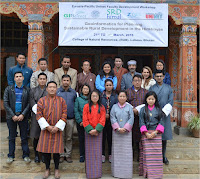The GIScience Commission of the Austrian Academy of Sciences (OeAW-GIScience) and the Interfaculty Department of Geoinformatics - Z_GIS, University of Salzburg, Austria cooperated in organising a regional workshop focussing on 'Geoinformatics for Planning Sustainable Rural Development in the Himalayas (SRD-himal)' in Lobeysa, Bhutan from 21st to 25th March, 2016.
 |
| Participant of SRD-himal Workshop |
Prof. Josef Strobl and Dr. Shahnawaz coordinated the workshop and it was hosted by the College of Natural Resources (CNR), Royal University of Bhutan (RUB) and Mr. Ugyen Thinley was the local organizer. Supported by the Eurasia-Pacific Uninet, this advanced training for teachers and postgraduate students benefitted 18 participants from Bhutan, Nepal and Austria. The participants have multidisciplinary backgrounds in Geography, Rural Development, Forestry, Agriculture and Animal Husbandry. During the workshop, they learnt the concepts of rural development and performed geospatial analyses using ArcGIS software.
Dr. Phub Dorji (Director General, CNR) chaired the concluding session and awarded certificates to the participants. He expressed immense satisfaction about the learning outcomes presented by the participants and conveyed that CNR would be prepared to host such a workshop in the future






